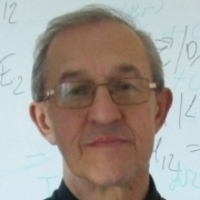
Igor Izmailov
Over 40 years of professional research activity in the field of pure and applied physics related to actual problems of modern laser, plasma, nano-,-bio-, and other emerging technologies, including multidisciplinary projects in the framework of national and international programs: STCU, NKAU, DFFD, RFBR, EC INTAS, EUREKA, FP7, HORIZON 2020. Area of expertise: atomic and molecular physics, condensed matter physics, laser physics, plasma physics, chemical physics, thermal physics, thermodynamics, fluid dynamics, physical-chemical kinetics, radiation, optics, spectroscopy, fluorescence, luminescence, chemiluminescence, photoluminescence, photochemistry, photocatalysis, electrical discharges, combustion, explosion, energy conversion, photonics, quantum electronics, lasers, sensors, waveguides, remote sensing, environmental monitoring, modeling, diagnostics and analysis. Over 200 publications in scientific journals and conference proceedings, 5 patents/author's certificates on inventions. Member of SPIE/Ukraine and Ukrainian Physical Society
Supervisors: Academician S.I. Pekar (past) and Professor V.A. Kochelap
Address: Prospect Nauki 45, Kiev, 03028 Ukraine
Supervisors: Academician S.I. Pekar (past) and Professor V.A. Kochelap
Address: Prospect Nauki 45, Kiev, 03028 Ukraine
less
Related Authors
Vyacheslav Tsiolko
Institute of Physic of NASU
Vadym Naumov
National Academy of Sciences of Ukraine
VICTORIA A N A T O L Y I V N A TSYGANKOVA
Institute of Bioorganic Chemistry and Petrochemistry of National Academy of Sciences of Ukraine, Kyiv
Victoria Tsygankova
Institute of Bioorganic Chemistry and Petrochemistry of National Academy of Sciences of Ukraine, Kyiv
Oleg Nedybaliuk
Taras Shevchenko National University of Kyiv
Peter Baricholo
National University of Science & Technology
InterestsView All (41)





Uploads
Papers by Igor Izmailov
The basic physical aspects (optical, kinetical, thermal and fluid dynamical) in operation of gas flow lasers on electronic transitions are discussed. The perspective electronically excited diatomic molecules (halogens, halkogens and other possible candidates from the elements of Group VI and VII) as the potential lasants, and exoenergic gas-phase reactions of radiative recombination of atoms (S + S, Cl + Cl, Br + Br and others) as the promising way to pump a high energy gain media in the gas flow are considered. The key spectral and kinetic characteristics (recombination efficiency, its branching ratio, quantum yield, rates of E-V-T energy relaxation, radiative lifetime, etc.) important for excitation of the (B − X) band systems of S 2, Cl 2, Br 2 and other molecules are analyzed. The initial thermodynamic parameters, gas mixture composition, pressure and temperature regimes and other conditions necessary for the population inversion and the light amplification sufficient for laser generation in recombining supersonic flows are searched and optimized. The complex strategy of research which includes the pre-laser gasdynamic modeling by ‘shock tube’ technique and photochemical modeling by ‘flash tube’ technique to understand a behavior of generator/amplifier laser system are proposed and tested.
As a result of conducted pre-laser studies, the principal possibilities to develop the new powerful laser sources for the wide range of wavelengths in visible and near-IR spectrum are found. Expected performance and advanced applications are discussed also.
The basic physical aspects (optical, kinetical, thermal and fluid dynamical) in operation of gas flow lasers on electronic transitions are discussed. The perspective electronically excited diatomic molecules (halogens, halkogens and other possible candidates from the elements of Group VI and VII) as the potential lasants, and exoenergic gas-phase reactions of radiative recombination of atoms (S + S, Cl + Cl, Br + Br and others) as the promising way to pump a high energy gain media in the gas flow are considered. The key spectral and kinetic characteristics (recombination efficiency, its branching ratio, quantum yield, rates of E-V-T energy relaxation, radiative lifetime, etc.) important for excitation of the (B − X) band systems of S 2, Cl 2, Br 2 and other molecules are analyzed. The initial thermodynamic parameters, gas mixture composition, pressure and temperature regimes and other conditions necessary for the population inversion and the light amplification sufficient for laser generation in recombining supersonic flows are searched and optimized. The complex strategy of research which includes the pre-laser gasdynamic modeling by ‘shock tube’ technique and photochemical modeling by ‘flash tube’ technique to understand a behavior of generator/amplifier laser system are proposed and tested.
As a result of conducted pre-laser studies, the principal possibilities to develop the new powerful laser sources for the wide range of wavelengths in visible and near-IR spectrum are found. Expected performance and advanced applications are discussed also.